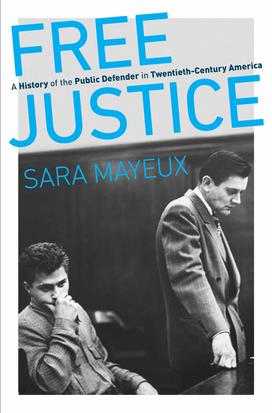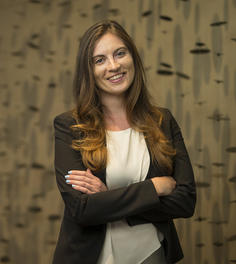Sara Mayeux ’05 Chronicles History of Public Defenders in the U.S.

The book: Although now a staple of the American criminal justice system, Free Justice: A History of the Public Defender in Twentieth-Century America (UNC Press) discusses the contentious, and relatively recent, origins of public defenders in the United States. Mayeux takes readers through the history of the proliferation of public defenders while delving into the complexities of American ideals of justice, democracy, and fairness in the 20th century.
The author: Sara Mayeux is an associate professor of law at Vanderbilt University. Mayeux earned her law degree, as well as a Ph.D. in history, from Stanford University. Before joining Vanderbilt’s law faculty in 2016, she was a Sharswood Fellow at the University of Pennsylvania Law School and the Berger-Howe Legal History Fellow at Harvard Law School. Before entering the legal academy, she clerked for Judge Marsha S. Berzon of the U.S. Court of Appeals for the Ninth Circuit.

Opening lines: The Cold War was everywhere in 1955, but where could an American go and see it? Maybe to Korea, or Warsaw, or Bandung. Ellery Cuff was a “Northern California farm boy” who had grown up to become the public defender of Los Angeles County, and he did not think anyone needed to travel so far away. If they wanted to observe firsthand the contrast between democracy and totalitarianism, they needed only to visit his office. Cuff and his deputies provided free legal representation, at public expense, for anyone in Los Angeles who was accused of committing a serious crime and could not afford a lawyer. Cuff believed his work exemplified the “democratic doctrine of the dignity and paramount importance of the individual.” Only in a free society, Cuff implied, would the state not only accuse, but also provide a defense for the accused. Under communist rule, “the state is all, the individual is nothing.” In the United States, public defenders and other protections for the accused instantiated “the profound belief that the individual, his rights and safeguards make up the central nexus of existence, and the state only justifies its existence by protecting these rights and safeguards.” “The lot of the public defender is not always a happy one,” Cuff acknowledged. But in the public defender’s daily activity, visiting jails and arguing in court on behalf of indigent men and women accused of murder and other serious felonies, Cuff found the essence of liberal democracy.
Four years later, the New York lawyer Harrison Tweed expressed a similar view, suggesting that public defenders could help to prove the “workability of our American way of life.” A “handsome playboy” from a family of prominent lawyers, Tweed had enrolled in law school as a young man only because his father promised, in exchange, to buy him a polo pony. Now he was a senior partner in the clubby Wall Street law firm that existed primarily to provide legal counsel for the Rockefeller family and that family’s prize investment, the Chase Manhattan Bank. Tweed was three thousand miles away from Cuff and many rungs above him in the profession’s internal status hierarchy, which tended to peg a lawyer’s prestige to the wealth of his clients. But both men spoke the lingua franca of Cold War American liberalism. In a political moment defined by apparent consensus – at least among elites and professionals – liberalism connoted not a partisan platform, but a set of principles ostensibly shared across political, geographic, and class divides; among them, a commitment to individual rights and national unity, and a belief in the uniquely egalitarian potential of American law and legal institutions.
Like all invocations of “the American way,” these statements equating the public defender with liberal democracy were arguments, not factual descriptions. In most of the United States, there were no public defenders in the 1950s. In this respect Ellery Cuff’s Los Angeles, having established the nation’s first public defender decades earlier during the Progressive Era, was unusual. But the landscape would soon change dramatically, now that the public defender had the endorsement of professional leaders like Harrison Tweed. By 1973, nearly two-thirds of Americans live in an area served by a public defender. That same year, a federal commission recommended that every local jurisdiction maintain “a full-time public defender organization.” By the end of the twentieth century, eight out of ten felony defendants in urban counties were represented by a publicly funded lawyer.
Today, public defenders form part of the American way of life in the literal sense. There are thousands of public defenders all around the country, and millions of Americans each year rely on them for legal advice and courtroom advocacy. To be sure, some jurisdictions still do not have full-time public defenders and instead contract out the work piecemeal; other cities have only very recently established public defenders’ offices, which remain weakly supported. Nor do public defenders receive material support commensurate with the rhetorical esteem they inspire. Advocates decry public defenders’ inadequate budgets and debate whether the federal government should do more to supplement state and local resources for indigent defense. In a moment of widespread concern about mass incarceration, lawyers and legal scholars question whether defendants’ fates are predetermined by draconian sentencing laws, racial bias, and “tough-on-crime” politics. But all of these caveats only confirm that public defenders have grown roots in American legal culture. Only because public defenders are central to the day-to-day operations of the criminal courts do advocates and scholars engage in vigorous debate about how they should be funded and how they fit into larger discussions about criminal law and policy. …
This book seeks to explain how and why lawyers came to believe in the public defender as a quintessentially American institution, one that ideally should exist in communities all around the country. However, it does not tell this story in the way that bar leaders themselves have often told it. This is not a story of lawyers finding easy consensus around an apolitical, professional commitment to “due process” or the “rule of law.” Rather, it is a story of contestation and uncertainty within the legal profession — even within the minds of individual lawyers — over the proper relationship between lawyers, markets, and the modern state. As they puzzled over how to protect the rights of the accused, lawyers confronted in their own professional realm the same dilemmas that confronted America writ large in the twentieth century, as reformers and policymakers sought to accommodate the received legal and political traditions of agrarian settler colonies to an increasingly urban, industrial society and ultimately, a global superpower. … Rather than a specialized topic of interest only to legal scholars, the public defender merits a place within the mainstream of American political and cultural history. The story of its development into a widespread institution offers insight into the contested meaning of American democracy and the contours and contradictions of twentieth-century liberalism.
Review: "Mayeux reveals core features of American political culture and political economy across a changing twentieth century. This is a brilliant book that should be read by everyone interested in the dimensions of the contemporary American legal regime." —Hendrik Hartog, Class of 1921 Bicentennial Professor in the History of American Law and Liberty, Emeritus, Princeton University











No responses yet